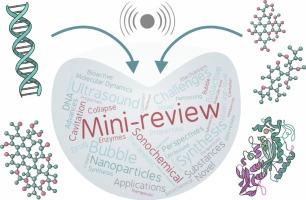Sonochemical synthesis of nanoparticles from bioactive compounds: advances, challenges, and future perspectives
IF 9.7
1区 化学
Q1 ACOUSTICS
引用次数: 0
Abstract
Sonochemical synthesis, driven by acoustic cavitation, has emerged over the past two decades as a powerful and versatile method for producing nanoparticles of bioactive substances with enhanced physicochemical and biological properties. The extreme conditions generated by the collapse of cavitation bubbles – such as transient high temperatures and pressures – facilitate molecular fragmentation, nucleation, and controlled nanoparticle growth. These characteristics make sonochemistry particularly well suited for nanosizing pharmaceuticals, enzymes, and natural bioactive compounds. In addition to a wide range of experimental techniques, recent advances in molecular dynamics simulations have offered critical insights into the molecular-level mechanisms underlying sonochemical processes, revealing the roles of solvent interactions and interfacial dynamics in determining nanoparticle size and stability. This deeper understanding has enabled more precise tuning of synthesis parameters to achieve desired nanoparticle characteristics. Sonochemically synthesized nanoparticles have demonstrated significant potential in diverse biomedical fields, including targeted drug delivery, sonodynamic therapy, regenerative medicine, and antimicrobial coatings. This minireview consolidates two decades of research, highlighting key advancements in the sonochemical synthesis of nanoparticles of bioactive substances, with a focus on molecular-level insights, biomedical applications, future research directions, ongoing challenges, and future perspectives.

生物活性化合物声化学合成纳米颗粒:进展、挑战和未来展望
在过去的二十年里,由声空化驱动的声化学合成已经成为一种强大而通用的方法,用于生产具有增强物理化学和生物特性的生物活性物质纳米颗粒。由空化气泡崩溃所产生的极端条件——如瞬态高温和高压——促进了分子破碎、成核和可控的纳米颗粒生长。这些特点使声化学特别适合于纳米化药物、酶和天然生物活性化合物。除了广泛的实验技术之外,分子动力学模拟的最新进展为声化学过程的分子水平机制提供了重要的见解,揭示了溶剂相互作用和界面动力学在决定纳米颗粒大小和稳定性方面的作用。这种更深入的理解使得更精确地调整合成参数以实现所需的纳米颗粒特性。超声化学合成的纳米颗粒在多种生物医学领域显示出巨大的潜力,包括靶向药物递送、声动力治疗、再生医学和抗菌涂层。这篇微型综述整合了二十年的研究,突出了生物活性物质纳米粒子声化学合成的关键进展,重点是分子水平的见解,生物医学应用,未来的研究方向,正在进行的挑战和未来的展望。
本文章由计算机程序翻译,如有差异,请以英文原文为准。
求助全文
约1分钟内获得全文
求助全文
来源期刊

Ultrasonics Sonochemistry
化学-化学综合
CiteScore
15.80
自引率
11.90%
发文量
361
审稿时长
59 days
期刊介绍:
Ultrasonics Sonochemistry stands as a premier international journal dedicated to the publication of high-quality research articles primarily focusing on chemical reactions and reactors induced by ultrasonic waves, known as sonochemistry. Beyond chemical reactions, the journal also welcomes contributions related to cavitation-induced events and processing, including sonoluminescence, and the transformation of materials on chemical, physical, and biological levels.
Since its inception in 1994, Ultrasonics Sonochemistry has consistently maintained a top ranking in the "Acoustics" category, reflecting its esteemed reputation in the field. The journal publishes exceptional papers covering various areas of ultrasonics and sonochemistry. Its contributions are highly regarded by both academia and industry stakeholders, demonstrating its relevance and impact in advancing research and innovation.
 求助内容:
求助内容: 应助结果提醒方式:
应助结果提醒方式:


